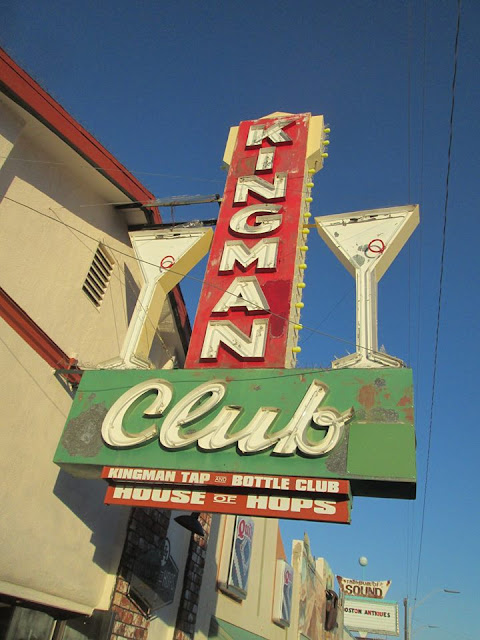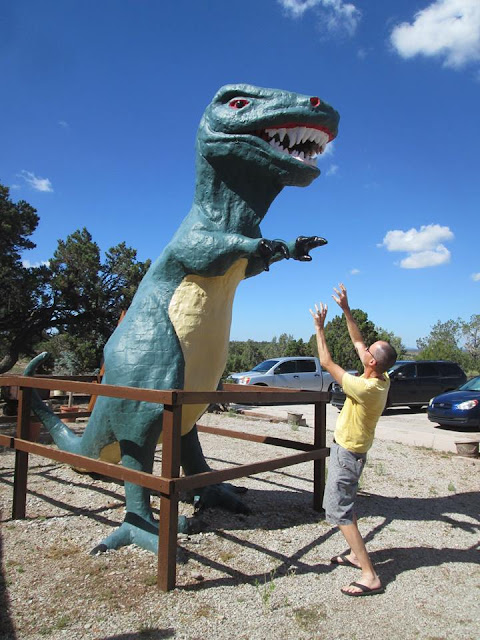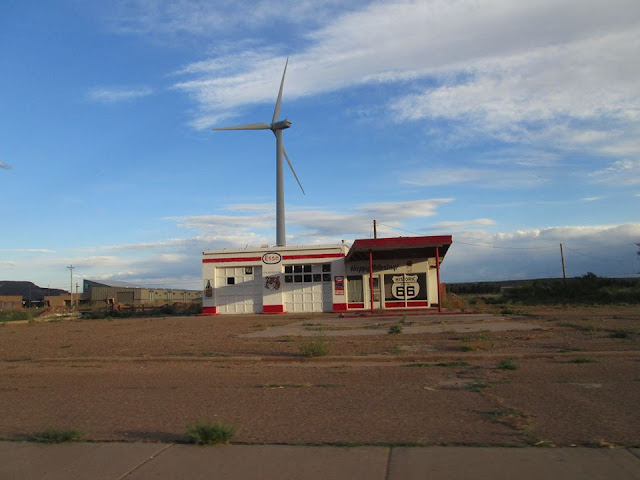Most of the original highway, built in 1926, has been co-opted by Interstate 40, although there remain all these little pockets of towns, just off the interstate that remain (barely) alive because of the sense of nostalgia that Americans (and, as it turns out, lots of Europeans) retain for a small two-lane highway that, for a certain number of decades in the 20th century, was the main route from Chicago to Los Angeles.
This was the road that the Joad family lumbered along during the Great Depression in John Steinbeck's The Grapes of Wrath. For the Joads, in their ramshackle jalopy, the road west promised survival, hope, and opportunity, just as it had for a generation of wagon-train pioneers before them. What they found at "the end of the trail" in California was, of course, more squalor, but their steadfast (perhaps delusional) optimism represents something quintessentially American.
As my father and I passed through rough and ramshackle barely-alive towns like Hackberry, Amboy, Ludlow, Santa Rosa, and Tucumcari--some of them so tiny you could almost sneeze and miss them--I felt those mixed feelings of love, nostalgia, and squalor. Old crumbling billboards still line stretches of the original Route 66, and the towns themselves are filled with boarded-up, decaying little motels, diners, and gas stations. Many of these buildings are left as-is, remain closed but not destroyed because they have become a part of American history--like the ruined castles of Europe--remnants of another time. Our Triple A map of Route 66 describes some of these places as "the town that time forgot." There is a sort of sadness to a broken down motel, but there is also an undeniable charm, even whimsy to it all.
Of course, we also encountered some real human squalor, like Gabriel, the young Navajo man outside the gift shop of the Grand Canyon Caverns, who was drunk and sad-looking. He asked us for a ride "back," though he didn't say where, and when we told him that our car was a two-seater, he offered to "ride on top." Like the Joads.
We passed through a good deal of "Indian Country" on Route 66 and, as two educated 21st century Americans, my dad and I reflected on that tragic legacy. How does Gabriel feel about the Wigwam Motel, where you can "Sleep in a real wigwam," with its ultra-kitschy co-opting of native American culture? That, too, is Route 66--the Indian gift shops and the real life reservations we passed through on our trip through American nostalgia/memory/squalor. In the Old Plaza in Santa Fe, New Mexico, there stands a monument "To the heroes who have fallen in the various battles with Indians in the territory of New Mexico," and 200 feet away, lots of real-life Indians sell turquoise jewelry, leather, artwork, and fry bread. This, too, is Route 66.
But I'm getting ahead of myself. My purpose here is to provide a kind of photo-essay of my route 66 adventure with my dad in the summer of 2016. I will present the trip state-by-state, beginning with California, and ending in Illinois. Buckle your seatbelts, folks. Here we go...
California
The actual end-point of Route 66 is the Santa Monica pier, in Los Angeles. However, since my dad and I live in California, near Los Angeles, that's where we began. Here's a picture of us at the end (beginning) of the trail.
Our first stop outside Los Angeles was the lovely town of Victorville, where we encountered the first of many Route 66 Museums.
Continuing east, we came upon Bottle Tree Ranch, which was not on our map, but which I'd read about in a great book called Weird California. Here are some photos I took of this unique roadside attraction.
And then we came upon some serious desert. Our first three days would primarily take us through the American southwest, where the heat would reach upwards of 115 degrees. We had lunch at the Bagdad Cafe, which was made famous by a 1987 German film of the same name and an especially surreal episode of Huell Howser's California's Gold, where he visits the cafe and marvels over the portrait of Burt Lancaster. Here's the Bagdad Cafe.
In the eastern Mojave Desert in California, between Barstow and Needles, we encountered the first natural wonder of our trip, the Amboy Crater Natural Monument. Before arriving at the crater, we noticed that the desert landscape was spotted with black rocks, and wondered why. As it turns out, the Amboy Crater is a young volcano, which explains the black rock. This was probably the hottest point in our entire trip (around 115 degrees). We decided to forego the 3-mile hike to the crater.
In the nearby town of Amboy, California were some classic Route 66 things: a large plastic hot dog, Roy's Motel Cafe (still operational), and Road Runner's Retreat Restaurant (defunct). A recurring image along Route 66 is the iconic roadrunner from Looney Tunes, as this looks like the landscape he would run through in his endless escapes from that Wily Coyote.
Around sunset, we crossed the mighty Colorado River into Arizona.
Arizona
We spent the night in Kingman, Arizona, a cool little town with some neat old buildings.
We set out early in the morning of what would turn our to be our longest day of travel. Our first stop was Hackberry General Store, which was like a ramshackle museum of old cars, signs, and all things Route 66.
At the Hackberry General Store, there was a cat that followed us around and even posed for a picture.
Our next stop was the Grand Canyon Caverns, which I was really excited about because you got to take an elevator down into these old caves. Unfortunately, the elevator was not working that day. Thankfully, we did get to check out Dinosaur City.
We ate at the famous Roadkill Cafe in Seligman, Arizona. Their motto is "You kill it, we grill it." This turned out not to be the case. I had a very nice, normal breakfast there.
Down the road a bit in Seligman was another famous roadside attraction called Delgadillo's Snow Cap Drive In, which opened in 1953.
East of Flagstaff, Arizona, in the middle of the desert, we came upon a very cool Meteor Crater, which impacted the earth about 50,000 years ago. Because its surface resembles the surface of the moon, astronauts from some of the Apollo missions trained here.
Near Joseph City, we came upon Jackrabbit's Trading Post, with its famous sign "HERE IT IS."
And then we came to the second teepee-themed motel along Route 66 (The other is in Rialto, California), the Wigwam Motel.
I was looking forward to seeing the famous "Painted Desert" in Arizona, and I was not disappointed. It does look painted.
In the painted desert, we also saw a magnificent petrified forest. It was really surreal--all these rock-trees in the middle of a desolate desert. We learned that these trees are evidence that, millions of years ago, this desert was actually a lush rainforest, populated with dinosaurs and other creatures.
New Mexico
We spent the night in Grants, New Mexico on the Fourth of July, and here we had our only car issue. What began as a slow leak turned into a flat tire, and we were lucky that the guy who owned the only tire shop in town was willing to fix our tire over the holiday. Our first stop in New Mexico was Petroglyph National Monument, just outside of Albuquerque, which contains several fascinating stone drawings made by Ancestral Pueblo people, dating back thousands of years.
And then we came to Santa Fe, New Mexico, which neither of us had ever visited. It's a truly beautiful city to behold, with mostly adobe buildings. The photos I took do not do justice to the grandeur of the city. We both wished we had more time in Santa Fe to explore its numerous museums and galleries. We did get to explore the old downtown plaza, and some of the interesting old streets of downtown.
If I had to choose one town that is a perfect microcosm of what Route 66 truly is, it would be Tucumcari, New Mexico, a lovely conglomeration of the kind of old motels, cafes, and gas stations that once dominated this historic highway. My friend Charlie Pecoraro made a great documentary film called Circle the Wagen, about a cross country trip he took in a broken down VW bus, in which Tucumcari was featured prominently, particularly the Blue Swallow Inn, where Charlie's bus spent four years awaiting repair. Here are some photos of the iconic Tucumcari.
As we crossed the border into Texas, a giant storm cloud chased us, sort of like in that movie Twister, but we beat it!
Texas
At a supermarket in Amarillo, Texas, the middle-aged checkout woman with a thick Texas accent, probably detecting our California accents, asked, "Where y'all from?"
"Southern California," we said, "We're heading to Chicago on Route 66."
She told us that we had to check out the great big cross just down the road in Groom, Texas.
"It's almost thirty feet high. Zach Thomas' dad put it up there." I later learned that Zach Thomas played football for the Dallas Cowboys.
The woman suggested that we do what she did when she visited the cross, which was to have her picture taken in front of it and then frame that picture. We agree that that would be a good idea.
As I stood outside the supermarket, sipping coffee and waiting for my dad to bring the car around, a big guy walked by and said, "Y'on breaker whut?"
He said this so fast that it sounded like one word: Yonbreakerwhut? I honestly didn't know what he meant, so I just smiled and nodded. As he got in his big truck (ridiculously big trucks are omnipresent in Texas), I realized what he had asked me was, "Are you on break, or what?" The Texas accent is strange to me. Anyway, here is a picture of the "great big cross" in Groom Texas, which was actually kind of impressive, and way taller than thirty feet.
As someone who doesn't own or drive a car, I don't pay much attention to gas prices, but spending a week on the road with my dad, I noticed such things. I was shocked that gas prices in Texas and the South in general were much lower than in California. The obvious reason is that taxes are higher in California, but I think it may also have to do with oil subsidies, and the vast oil fields of Texas. On a less depressing note, I was pleasantly surprised to observe that there is a massive wind farm in Texas that stretches for miles and miles.
We checked out the famous "Leaning Water Tower of Texas."
Along Route 66, there are lots of quirky little museums, but perhaps the most unique was the Devil's Rope (Barbed Wire) Museum in the tiny town of McLean, Texas. I was expecting a little one-room operation, but this museum is VAST and EXTENSIVE. Who knew that something so seemingly ordinary as barbed wire has such an important and complex history, but it does. You could literally spend half a day in the barbed wire museum, it's that extensive.
No trip along Route 66 is complete without stopping at the U-Drop Inn in Shamrock, Texas. Here is the iconic Conoco station that was the inspiration for one of the buildings in the Disney movie Cars. As it turns out, most of the vehicles and buildings in Cars were inspired by different places along Route 66. The U-Drop Inn is a beautiful art deco structure built in 1936.
And no trip through Texas is complete without eating at a Texas steakhouse. We had an amazing lunch at Big Vern's in Shamrock.
Oklahoma
And then we crossed the border into Oklahoma, another state I'd never visited. We exited the highway and drove through the town of Clinton because we'd seen a sign a while back that said "Spaceport." What would a spaceport be doing in Clinton, Oklahoma? We had to find out. Wouldn't it be amazing if there really was a functioning spaceport here, with alien craft from across the universe stopping to refuel their space ships and maybe have a drink--sort of like Mos Eisley Cantina in Star Wars. What if such a thing existed and somehow the only people who knew about it were the residents of Clinton, Oklahoma? Stopping at the Dairy Queen for a refreshing beverage, my dad asked two different employees about the spaceport, and they knew nothing about it (or so they claimed).
In the small town of Arcadia, Oklahoma there are two notable roadside attractions: Pops (a store with hundreds of varieties of "pop"), and the Round Barn of Arcadia.
Down the road a bit, in the town of Chandler, we popped into the Route 66 Interpretive Center, which is in a very impressive 1930s building which was formerly a National Guard Armory. Now it's a museum. I got to meet two very nice ladies inside named Marilyn and Susan.
In Catoosa, OK we had to check out the big blue whale. Amazingly, here we ran into someone from Buena Park, California (the town right next to Fullerton, where I live) who is attending Fullerton College (where I teach English). Small world!
Driving through Commerce, OK I noticed a statue in front of a baseball field that turned out to be a statue of Mickey Mantle, who grew up and played baseball here.
We stopped at a gas station in Commerce and the woman told us where to find Mickey Mantle's childhood home. She also gave us a brief history of Commerce, which used to be a lead mining town, and was now classified as a Superfund site. My dad explained that Superfund sites are places where there was such environmental damage and toxicity that the federal government had to spend lots of money to clean them up. Anyway, here I am in front of Mickey Mantle's childhood home.
Kansas
Route 66 goes through one small corner of Kansas, and we stopped in the town of Galena, where there is the tow truck that the character of Mater (again, from the movie Cars) was based on.
Missouri
We spent the night in Rolla, Missouri and headed out early the next morning for our final day of travel! First, we passed through the small town of Cuba, which is known as "the city of murals," and there were quite a few murals, mostly dealing with American history.
I was super excited for our next destination, the Meramec Caverns, which are these really beautiful caves (complete with stalactites) where the famous outlaw Jesse James once hid out after a robbery. This was definitely a hi-light of Route 66.
Next we drove through St. Louis and saw the famous Gateway Arch.
We stopped for lunch at Weezys in Hamel, a roadside diner that has been open since the 1940s, and had fried pickle spears!
In the town of Mt. Olive, Illinois there are two roadside attractions: Soulsby Shell Station, built the same year as Route 66 (1926), and the Mother Jones Monument/Union Miner's Cemetery. Mother Jones was a famous American labor leader.
We saw the famous Ariston Cafe, the oldest continuously operating cafe along Route 66.
In Springfield, we visited the home of Abraham Lincoln. The whole neighborhood around the Lincoln home has been preserved to look basically like it looked in the 19th century. My dad and I walked around this historic neighborhood and talked about the legacy of Abraham Lincoln.
As night fell on our sixth day of travel, we drove into Chicago and found the end-point of Route 66 downtown. We made it! 2,500 miles, eight states, and lots of fascinating Americana...

















































































